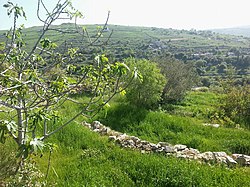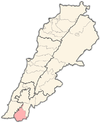| Baraashit برعشيت | |
|---|---|
| Municipality | |
 Pastoral view of Baraashit Pastoral view of Baraashit | |
 | |
| Coordinates: 33°10′34″N 35°26′36″E / 33.17611°N 35.44333°E / 33.17611; 35.44333 | |
| Grid position | 191/286 PAL |
| Country | |
| Governorate | Nabatieh Governorate |
| District | Bint Jbeil District |
| Area | |
| • Total | 14.05 km (5.42 sq mi) |
| Elevation | 832 m (2,730 ft) |
| Highest elevation | 840 m (2,760 ft) |
| Lowest elevation | 640 m (2,100 ft) |
| Time zone | UTC+2 (EET) |
| • Summer (DST) | UTC+3 (EEST) |
| Dialing code | +961 (07) |
Baraashit (Arabic: برعشيت), also spelt Brashit, is a municipality located in the Nabatiye Governorate, in the Bint Jbeil District of southern Lebanon, ca. 3.5 kilometres (2.2 mi) southeast of Tibnin and about 80 kilometres (50 mi) from Beirut. The village sits on an elevation of 832 metres (2,730 ft) above sea level. The town has a mixed population of Shi'a and Christians.
History
Baraashit is identified with Barashta (Hebrew: ברשתה), a place referenced in the Baraita on the "Boundaries of the Land of Israel" as part of the delineation of the northwestern border of Jewish resettlement following the return from Babylonian exile. Scholarly analysis suggests that this text likely describes a later era, possibly the Hasmonean or Herodian periods, during the 2nd or 1st century BCE. Additionally, the place is documented in the 3rd-century Mosaic of Rehob.
By 64 BCE, the region had come under the control of the Roman empire. The area was also known since the Muslim conquest as Jabal 'Amilah, and later as Jabal 'Amil (Jabal Amel), an area that shoulders the Galilee and overlooks Palestine, with a predominant Shi'ite population.
Ottoman era
In 1596, the village Bra'sit was named in the Ottoman nahiya (subdistrict) of Tibnin under the Liwa Safad, with a population of 45 households and 7 bachelors, all Muslim. The villagers paid taxes on agricultural products, such as wheat, barley, olive trees, fruit trees, goats and beehives, in addition to "occasional revenues" and a fixed sum; a total of 13,370 akçe.

In 1875, Victor Guérin visited, and found here "a cistern partly cut in the rock, and partly constructed, seems ancient." He found 400 Metawileh and 60 Greek Orthodox.
In 1881, British explorers, C. R. Conder and H. H. Kitchener, surveyed parts of southern Lebanon, mentioning ten villages in the Belad Besharah region, among which is listed Ber'ashit (sic): "A large village, containing about 500 Metawileh and 200 Christians. It is situated on the side of a hill, and surrounded by figs, olives, and arable cultivation. There is a good spring and several cisterns in the village."
Modern era
The current Bint Jbeil province was created in 1922 by French colonials.
Following the Israeli invasion of Lebanon in 1982, Baraashit remained part of the Israeli security zone and became the scene of recurring incidents. On 10 January 1987 an Irish soldier serving with UNIFIL was killed by Israeli tank fire near Baraashit. At the time there were 750 Irish troops with UNIFIL. A further three Irish soldiers were killed, 21 March 1989, by a landmine on the road to their outpost near Baraashit. Officers on the ground are reported as believing that the Israeli backed SLA were responsible and that UNIFIL were being deliberately targeted. On 11 October 1990 a member of Amal was killed in a clash with the South Lebanon Army (SLA). On 23 August 1991 two SLA fighters were killed by members of Amal. The Israeli Army responded the following day with shelling which killed one civilian. Two Irish soldiers serving with UNIFIL were amongst the wounded.
IDF shelling killed a schoolboy in Baraashit on 24 January 1993.
There was a SLA outpost a few hundred yards from Baraashit and whenever it came under attack the town was shelled. The town was extensively damaged during Operation Accountability, July 1993. The head of one family who had five houses completely destroyed is reported as complaining "How many Ministers from Beirut came down here to see the damage? Rabin visits Kiryat Shimona the minute one Katuysha hits it."
On 8 April 1996 two boys were killed by an IED concealed in a wall near Baraashit, three others wounded. Hizbollah responded by firing twenty-eight rockets at Kiryat Shimona, wounding thirteen residents. The incident is regarded as one of the triggers of Operation Grapes of Wrath later in the month which caused massive destruction across the south of Lebanon.
During the 2006 Lebanon War, Israel conducted an airstrike at the town. Later it was discovered that one of the homes struck was rented by Hezbollah, who used its basement to store weapons. When rumors of this activity spread, the organization acknowledged its actions and offered compensation to the family.
Demographics
In 2014 Muslims made up 93.40% and Christians made up 6.32% of registered voters in Baraashit. 92.19% of the voters were Shiite Muslims. The Christian population is mostly Greek Catholic.
In 2009, there were 55 members of the Lady of the Assumption parish of the Melkite Church in the village.
Climate

Baraashit enjoys a temperate climate which is characteristic of south Lebanon: Mild rainy winters and arid summers with a few excessively warm days.
References
- A proper noun used to designate a place, according to Palmer 1881, p. 19
- Baraachit, Lebanon – General Facts
- Frankel & Finkelstein 1983.
- Abel 1933, p. 309 (s.v. Meraḥseth).
- Frankel & Finkelstein 1983, p. 44.
- Klein & Hildesheimer 1965, pp. 58, 126.
- The World Book Encyclopedia, vol. 1, Chicago 1982, p. 151; The World Book Encyclopedia, vol. 12, Chicago 2002, p. 172; Jūrj Marʻī Ḥaddād, Baalbak, North and South Lebanon: Description, History and Tourist Guide, Damascus 1956, p. 10
- Carole H. Dagher, Bring Down the Walls: Lebanon's Post-War Challenge, New York 2000, p. 32 ISBN 978-0-312-29336-9
- Hütteroth and Abdulfattah, 1977, p. 179
- Note that Rhode, 1979, p. 6 Archived 2019-04-20 at the Wayback Machine writes that the register that Hütteroth and Abdulfattah studied was not from 1595/6, but from 1548/9
- Guérin 1880, p. 377, as given in Conder & Kitchener 1881, SWP I; p. 114
- Guérin 1880, p. 377.
- Conder & Kitchener 1881, p. 94.
- Ahmad Rida, Memoirs of History (مذكرات للتاريخ), Dar An-Nahar: Beirut 2009, pp. 138, 179, 180, 183, 227.
- Middle East International No 298, 17 April 1987; Publishers Lord Mayhew, Dennis Walters MP; Editor Michael Adams; John Keane p.11
- Middle East International No 347, 31 March 1989; John Keane pp.15-16
- Middle East International No 386, 11 October 1990, Fourteen days in brief p.15
- Middle East International No 408, 13 September 1991, Fourteen days in brief p.15
- Middle East International No 469, 18 February 1994; January chronology p.16
- Middle East International No 462, 5 November 1993, Cherif J. Cordahi 'Letter from South Lebanon' p.24
- Middle East International No 523, 12 April 1996; No 524, 26 April 1996; Michael Jansen p.8; Crisis chronology p.4
- Arsan, Andrew (2018). Lebanon: a country in fragments (First published in the United Kingdom ed.). London: Hurst & Company. p. 82. ISBN 978-1-84904-700-5.
- "التوزيع حسب المذاهب للناخبين/ناخبات في بلدة برعشيت، قضاء بنت جبيل محافظة النبطية في لبنان".
- "Territory and statistics". Eparchy Greek Melkite Catholic of Tyre. Archived from the original on 31 August 2018. Retrieved 29 August 2019.
Bibliography
- Abel, F.M. (1933). Géographie de la Palestine (in French). Vol. 1. Paris. OCLC 216266367.
{{cite book}}: CS1 maint: location missing publisher (link) - Conder, C.R.; Kitchener, H.H. (1881). The Survey of Western Palestine: Memoirs of the Topography, Orography, Hydrography, and Archaeology. Vol. 1. London: Committee of the Palestine Exploration Fund.
- Frankel, Raphael; Finkelstein, I. (1983). "'The Northwest Corner of Eretz-Israel' in the Baraita 'Boundaries of Eretz-Israel'". Cathedra: For the History of Eretz Israel and Its Yishuv. 27 (27): 39–46. JSTOR 23398920.
- Guérin, V. (1880). Description Géographique Historique et Archéologique de la Palestine (in French). Vol. 3: Galilee, pt. 2. Paris: L'Imprimerie Nationale.
- Hütteroth, W.-D.; Abdulfattah, K. (1977). Historical Geography of Palestine, Transjordan and Southern Syria in the Late 16th Century. Erlanger Geographische Arbeiten, Sonderband 5. Erlangen, Germany: Vorstand der Fränkischen Geographischen Gesellschaft. ISBN 3-920405-41-2.
- Klein, S.; Hildesheimer, N.Z. (1965). The Borders of the Land - Researches (in Hebrew). Jerusalem: Otzar hahochma. OCLC 868690016. (published post-mortem)
- Palmer, E.H. (1881). The Survey of Western Palestine: Arabic and English Name Lists Collected During the Survey by Lieutenants Conder and Kitchener, R. E. Transliterated and Explained by E.H. Palmer. Committee of the Palestine Exploration Fund.
- Rhode, H. (1979). Administration and Population of the Sancak of Safed in the Sixteenth Century. Columbia University. Archived from the original on 2019-04-20. Retrieved 2017-12-04.
External links
- Baraachit (Ber'ashit) in the Palestine Exploration Fund Map of 1878, Map 2: IAA, Wikimedia commons
- Baraachit, Localiban; Archived
